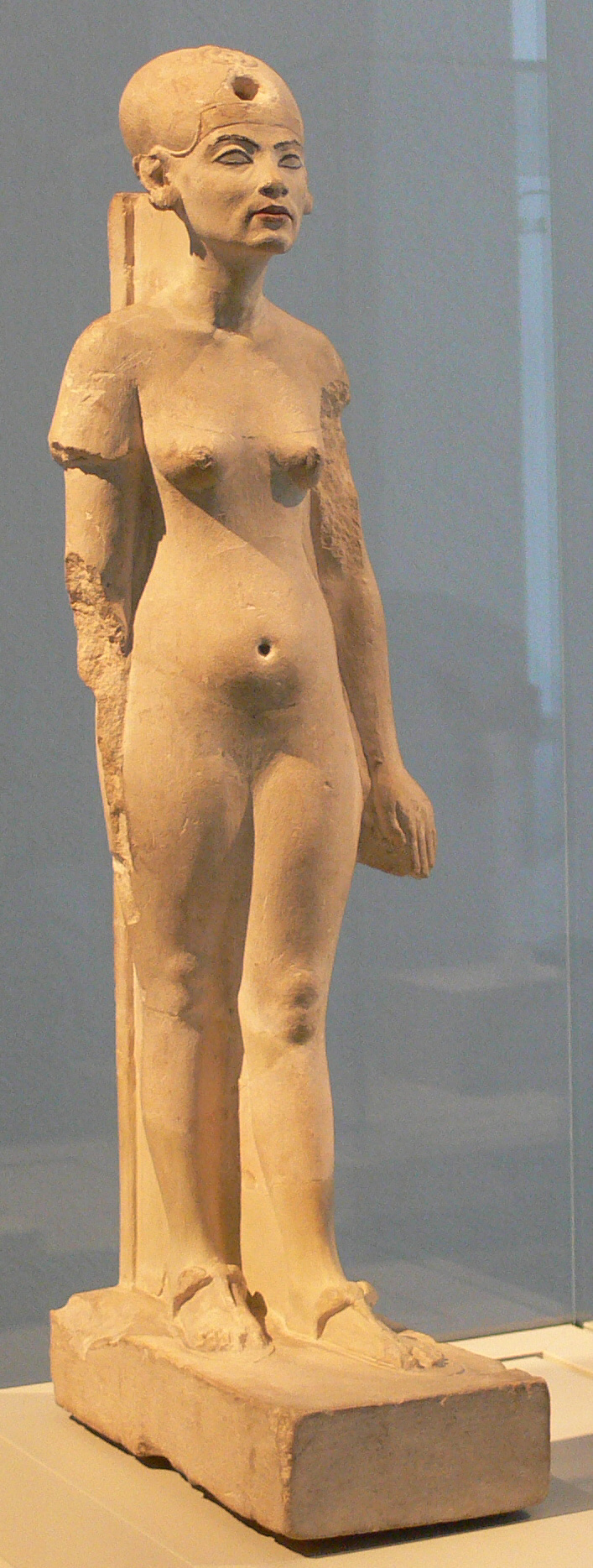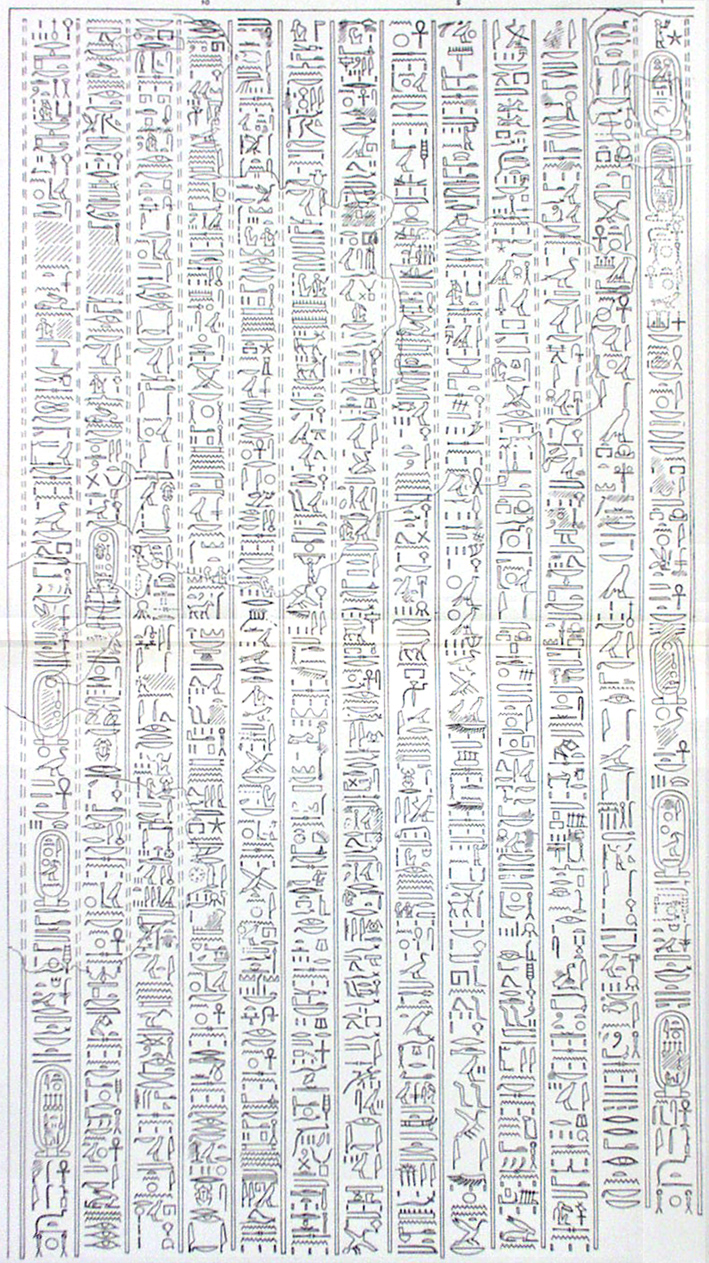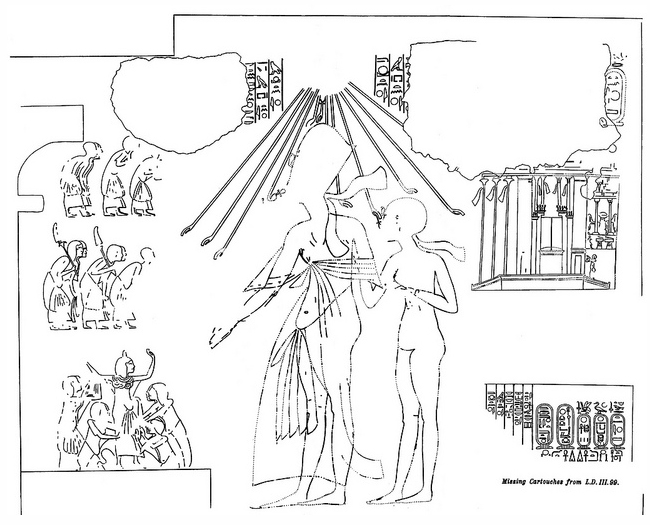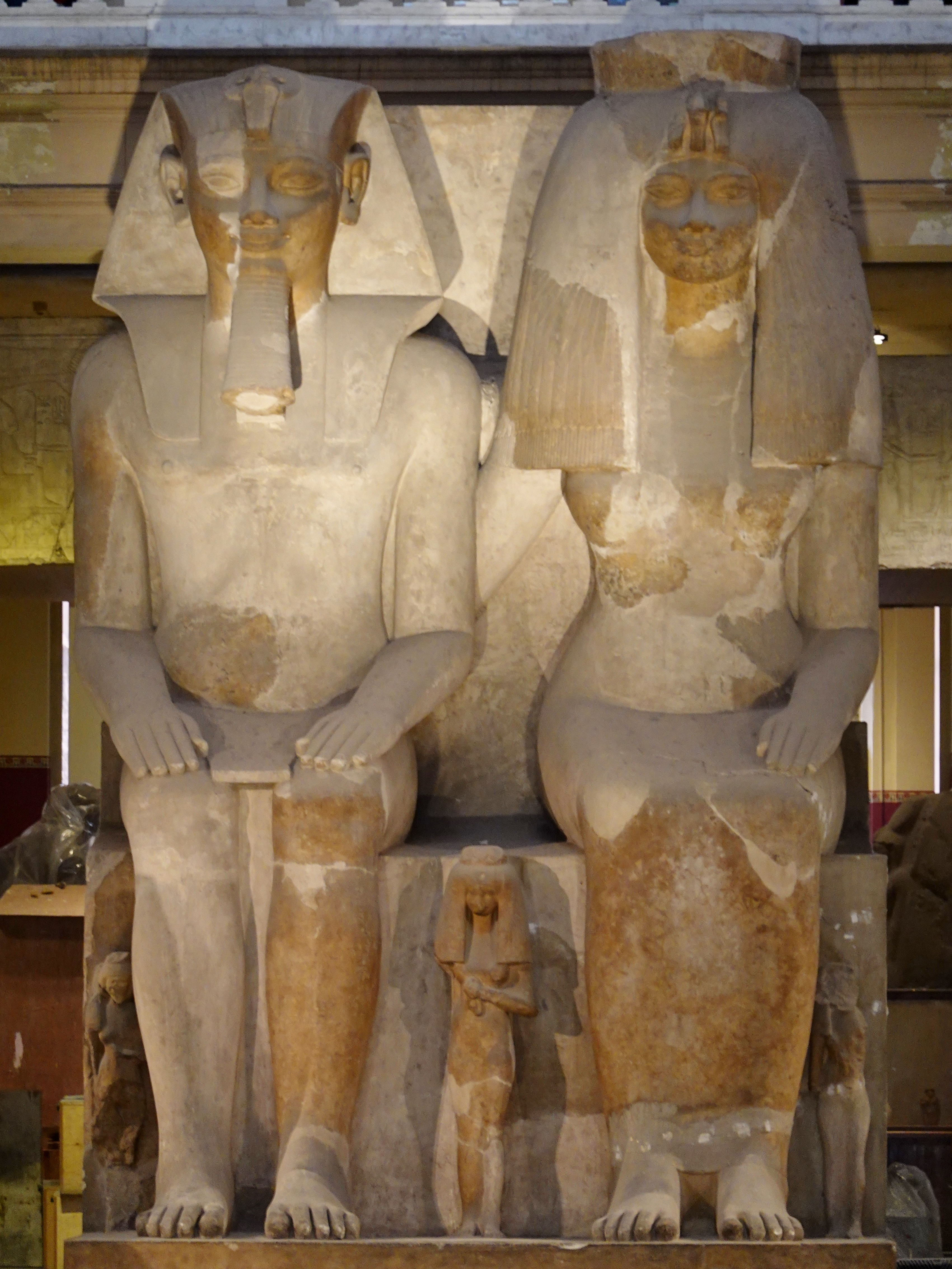|
Akhenaton
Akhenaten (pronounced ), also spelled Echnaton, Akhenaton, ( egy, ꜣḫ-n-jtn ''ʾŪḫə-nə-yātəy'', , meaning "Effective for the Aten"), was an ancient Egyptian pharaoh reigning or 1351–1334 BC, the tenth ruler of the Eighteenth Dynasty. Before the fifth year of his reign, he was known as Amenhotep IV ( egy, jmn-ḥtp, links=no, meaning " Amun is satisfied", Hellenized as ''Amenophis IV''). As a pharaoh, Akhenaten is noted for abandoning Egypt's traditional polytheism and introducing Atenism, or worship centered around Aten. The views of Egyptologists differ as to whether the religious policy was absolutely monotheistic, or whether it was monolatry, syncretistic, or henotheistic. This culture shift away from traditional religion was reversed after his death. Akhenaten's monuments were dismantled and hidden, his statues were destroyed, and his name excluded from lists of rulers compiled by later pharaohs. Traditional religious practice was gradually restored, no ... [...More Info...] [...Related Items...] OR: [Wikipedia] [Google] [Baidu] |
Atenism
Atenism, the Aten religion, the Amarna religion, or the "Amarna heresy" was a religion and the religious changes associated with the ancient Egyptian Eighteenth Dynasty pharaoh Akhenaten. The religion centered on the cult of the god Aten, depicted as the disc of the Sun and originally an aspect of the traditional solar deity Ra. In the 14th century BC, Atenism was Egypt's state religion for about 20 years, before subsequent rulers returned to the traditional polytheistic religion and the pharaohs associated with Atenism were erased from Egyptian records. History of Aten before Akhenaten The word ''Aten'' ( egy, jtn), meaning "circle," "disc," and later "sun disc," is first found in the 24th century BC Abusir Papyri, discovered in the mortuary temple of the Fifth Dynasty pharaoh Neferirkare Kakai. Aten, the god of Atenism, first appears as a god in texts dating to the Twelfth Dynasty, in the ''Story of Sinuhe''. During the Middle Kingdom, Aten "as the sun disk...was merely ... [...More Info...] [...Related Items...] OR: [Wikipedia] [Google] [Baidu] |
Nefertiti
Neferneferuaten Nefertiti () ( – c. 1330 BC) was a queen of the 18th Dynasty of Ancient Egypt, the great royal wife of Pharaoh Akhenaten. Nefertiti and her husband were known for a radical change in national religious policy, in which they promoted a form of proto-monotheism centred on the sun god Aten. With her husband, she reigned at what was arguably the wealthiest period of ancient Egyptian history. Some scholars believe that Nefertiti ruled briefly as Neferneferuaten after her husband's death and before the ascension of Tutankhamun, although this identification is a matter of ongoing debate.Dodson, Aidan, Amarna Sunset: ''Nefertiti, Tutankhamun, Ay, Horemheb, and the Egyptian Counter-Reformation''. The American University in Cairo Press. 2009, . If Nefertiti did rule as Pharaoh, her reign was marked by the fall of Amarna and relocation of the capital back to the traditional city of Thebes. She was made famous by her bust, now in Berlin's Neues Museum. The ... [...More Info...] [...Related Items...] OR: [Wikipedia] [Google] [Baidu] |
Aten
Aten also Aton, Atonu, or Itn ( egy, jtn, ''reconstructed'' ) was the focus of Atenism, the religious system established in ancient Egypt by the Eighteenth Dynasty pharaoh Akhenaten. The Aten was the disc of the sun and originally an aspect of Ra, the sun god in traditional ancient Egyptian religion. Akhenaten, however, made it the sole focus of official worship during his reign. In his poem "Great Hymn to the Aten", Akhenaten praises Aten as the creator, giver of life, and nurturing spirit of the world. Aten does not have a creation myth or family but is mentioned in the '' Book of the Dead''. The worship of Aten was initially dismantled by Tutankhamun and later eradicated by Tutankhamun's former military general Horemheb. Etymology and origin The word ''Aten'' appears in the Old Kingdom as a noun meaning "disc" which referred to anything flat and circular; the sun was called the "disc of the day" where Ra was thought to reside. By analogy, the term "silver aten" was s ... [...More Info...] [...Related Items...] OR: [Wikipedia] [Google] [Baidu] |
Smenkhkare
Smenkhkare (alternatively romanized ''Smenkhare'', ''Smenkare,'' or ''Smenkhkara''; meaning "'Vigorous is the Soul of Re") was an ancient Egyptian pharaoh of unknown background who lived and ruled during the Amarna Period of the 18th Dynasty. Smenkhkare was husband to Meritaten, the daughter of his likely co-regent, Akhenaten. Very little is known of Smenkhkare for certain because later kings sought to erase the Amarna Period from history. Because of this, perhaps no one from the Amarna Interlude has been the subject of so much speculation as Smenkhkare. Origin and family Smenkhkare's origins are unknown. It is assumed he was a member of the royal family, likely either a brother or son of the pharaoh Akhenaten. If he is Akhenaten's brother, his mother was likely either Tiye or Sitamun. If a son of Akhenaten, he was presumably an older brother of Tutankhamun, as he succeeded the throne ahead of him; his mother was likely an unknown, lesser wife. An alternative suggestion, base ... [...More Info...] [...Related Items...] OR: [Wikipedia] [Google] [Baidu] |
KV55
KV55 is a tomb in the Valley of the Kings in Egypt. It was discovered by Edward R. Ayrton in 1907 while he was working in the Valley for Theodore M. Davis. It has long been speculated, as well as much disputed, that the body found in this tomb was that of the famous king, Akhenaten, who moved the capital to Akhetaten (modern-day Amarna). The results of genetic and other scientific tests published in February 2010 have confirmed that the person buried there was both the son of Amenhotep III and the father of Tutankhamun. Furthermore, the study established that the age of this person at the time of his death was consistent with that of Akhenaten, thereby making it almost certain that it is Akhenaten's body.Hawass, Zahi et al. "Ancestry and Pathology in King Tutankhamun's Family" ''The Journal of the American Medical Association'' (2010) p. 644 However, a growing body of work soon began to appear to dispute the assessment of the age of the mummy and the identification of KV55 as Akh ... [...More Info...] [...Related Items...] OR: [Wikipedia] [Google] [Baidu] |
Tutankhamun
Tutankhamun (, egy, twt-ꜥnḫ-jmn), Egyptological pronunciation Tutankhamen () (), sometimes referred to as King Tut, was an Egyptian pharaoh who was the last of his royal family to rule during the end of the Eighteenth Dynasty (ruled in the conventional chronology) during the New Kingdom of Egyptian history. His father is believed to be the pharaoh Akhenaten, identified as the mummy found in the tomb KV55. His mother is his father's sister, identified through DNA testing as an unknown mummy referred to as "The Younger Lady" who was found in KV35. Tutankhamun took the throne at eight or nine years of age under the unprecedented viziership of his eventual successor, Ay, to whom he may have been related. He married his paternal half-sister Ankhesenamun. During their marriage they lost two daughters, one at 5–6 months of pregnancy and the other shortly after birth at full-term. His names—''Tutankhaten'' and ''Tutankhamun''—are thought to mean "Living image of At ... [...More Info...] [...Related Items...] OR: [Wikipedia] [Google] [Baidu] |
Meritaten
Meritaten, also spelled Merytaten, Meritaton or Meryetaten ( egy, mrii.t-itn) (14th century BC), was an ancient Egyptian royal woman of the Eighteenth Dynasty of Egypt. Her name means "She who is beloved of Aten"; Aten being the sun-deity whom her father, Pharaoh Akhenaten, worshipped. She held several titles, performing official roles for her father and becoming the Great Royal Wife to Pharaoh Smenkhkare, who may have been a brother or son of Akhenaten. Meritaten also may have served as pharaoh in her own right under the name Ankhkheperure Neferneferuaten.J. Tyldesley, ''Chronicle of the Queens of Egypt'', 2006, Thames & Hudson, pg 136–137 Family Meritaten was the first of six daughters born to Pharaoh Akhenaten and his Great Royal Wife, Nefertiti. Her sisters are Meketaten, Ankhesenpaaten, Neferneferuaten Tasherit, Neferneferure, and Setepenre. Meritaten is mentioned in diplomatic letters, by the name ''Mayati''. She is mentioned in a letter from Abimilki of Tyre. The refe ... [...More Info...] [...Related Items...] OR: [Wikipedia] [Google] [Baidu] |
Tiye
Tiye (c. 1398 BC – 1338 BC, also spelled Tye, Taia, Tiy and Tiyi) was the daughter of Yuya and Thuya. She became the Great Royal Wife of the Egyptian pharaoh Amenhotep III. She was the mother of Akhenaten and grandmother of Tutankhamun. In 2010, DNA analysis confirmed her as the mummy known as "The Elder Lady" found in the tomb of Amenhotep II ( KV35) in 1898. Family and early life Tiye's father, Yuya, was a non-royal, wealthy landowner from the Upper Egyptian town of Akhmim, where he served as a priest and superintendent of oxen or commander of the chariotry. Tiye's mother, Thuya, was involved in many religious cults, as her different titles attested (''Singer of Hathor'', ''Chief of the Entertainers'' of both Amun and Min...), which suggests that she was a member of the royal family. Egyptologists have suggested that Tiye's father, Yuya, was of foreign origin due to the features of his mummy and the many different spellings of his name, which might imply it was a non-E ... [...More Info...] [...Related Items...] OR: [Wikipedia] [Google] [Baidu] |
Ancient Egyptian Religion
Ancient Egyptian religion was a complex system of polytheistic beliefs and rituals that formed an integral part of ancient Egyptian culture. It centered on the Egyptians' interactions with many deities believed to be present in, and in control of the world. Rituals such as prayer and offerings were provided to the gods to gain their favor. Formal religious practice centered on the pharaohs, the rulers of Egypt, believed to possess divine powers by virtue of their positions. They acted as intermediaries between their people and the gods, and were obligated to sustain the gods through rituals and offerings so that they could maintain Ma'at, the order of the cosmos, and repel Isfet, which was chaos. The state dedicated enormous resources to religious rituals and to the construction of temples. Individuals could interact with the gods for their own purposes, appealing for help through prayer or compelling the gods to act through magic. These practices were distinct from, but closel ... [...More Info...] [...Related Items...] OR: [Wikipedia] [Google] [Baidu] |
Amarna
Amarna (; ar, العمارنة, al-ʿamārnah) is an extensive Egyptian archaeological site containing the remains of what was the capital city of the late Eighteenth Dynasty. The city was established in 1346 BC, built at the direction of the Pharaoh Akhenaten, and abandoned shortly after his death in 1332 BC. The name that the ancient Egyptians used for the city is transliterated in English as Akhetaten or Akhetaton, meaning " the horizon of the Aten".David (1998), p. 125 The site is on the east bank of the Nile River, in what today is the Egyptian province of Minya. It is about south of the city of al-Minya, south of the Egyptian capital, Cairo, and north of Luxor (site of the previous capital, Thebes). The city of Deir Mawas lies directly to its west. On the east side of Amarna there are several modern villages, the chief of which are l-Till in the north and el-Hagg Qandil in the south. Activity in the region flourished from the Amarna Period until the later Roman era ... [...More Info...] [...Related Items...] OR: [Wikipedia] [Google] [Baidu] |
Temple Of Amenhotep IV
The Temple of Amenhotep IV was an ancient monument at Karnak in Luxor, Egypt. The structures were used during the New Kingdom, in the first four years of the 18th Dynasty reign of the Egyptian Pharaoh Akhenaten, when he still used the name Amenhotep IV. The edifices may have been constructed at the end of the reign of his father, Amenhotep III, and completed by Akhenaten. Location and layout The Temple of Amenhotep IV was constructed outside the boundaries of the Precinct of Amon-Re, to its east. The main temple in the complex was named ''Gm–p3–itn'' (Gempaaten), which means "The Sun Disc is Found in the Estate of the God Aten". The other monuments were named ''Hwt–bnbn'' (Hwt benben / "The Mansion of the Benben stone"), ''Rwd–mnw–n–itn–r–nḥḥ'' (Rud-menu / "Sturdy are the Monuments of the Sun Disc Forever"), and ''Tni–mnw–n–itn–r–nḥḥ'' (Teni–menu / "Exalted are the Monuments of the Sun Disc F ... [...More Info...] [...Related Items...] OR: [Wikipedia] [Google] [Baidu] |
Egyptian Museum
The Museum of Egyptian Antiquities, known commonly as the Egyptian Museum or the Cairo Museum, in Cairo, Egypt, is home to an extensive collection of ancient Egyptian antiquities. It has 120,000 items, with a representative amount on display and the remainder in storerooms. Built in 1901 by the Italian construction company, Garozzo-Zaffarani, to a design by the French architect Marcel Dourgnon, the edifice is one of the largest museums in the region. As of March 2019, the museum was open to the public. In 2022, the museum is due to be superseded by the newer and larger Grand Egyptian Museum at Giza. History The Egyptian Museum of Antiquities contains many important pieces of ancient Egyptian history. It houses the world's largest collection of Pharaonic antiquities. The Egyptian government established the museum built in 1835 near the Ezbekieh Garden and later moved to the Cairo Citadel. In 1855, Archduke Maximilian of Austria was given all of the artifacts by the Egyptian ... [...More Info...] [...Related Items...] OR: [Wikipedia] [Google] [Baidu] |
_(Musée_du_Caire)_(2076972086).jpg)



.jpg)


